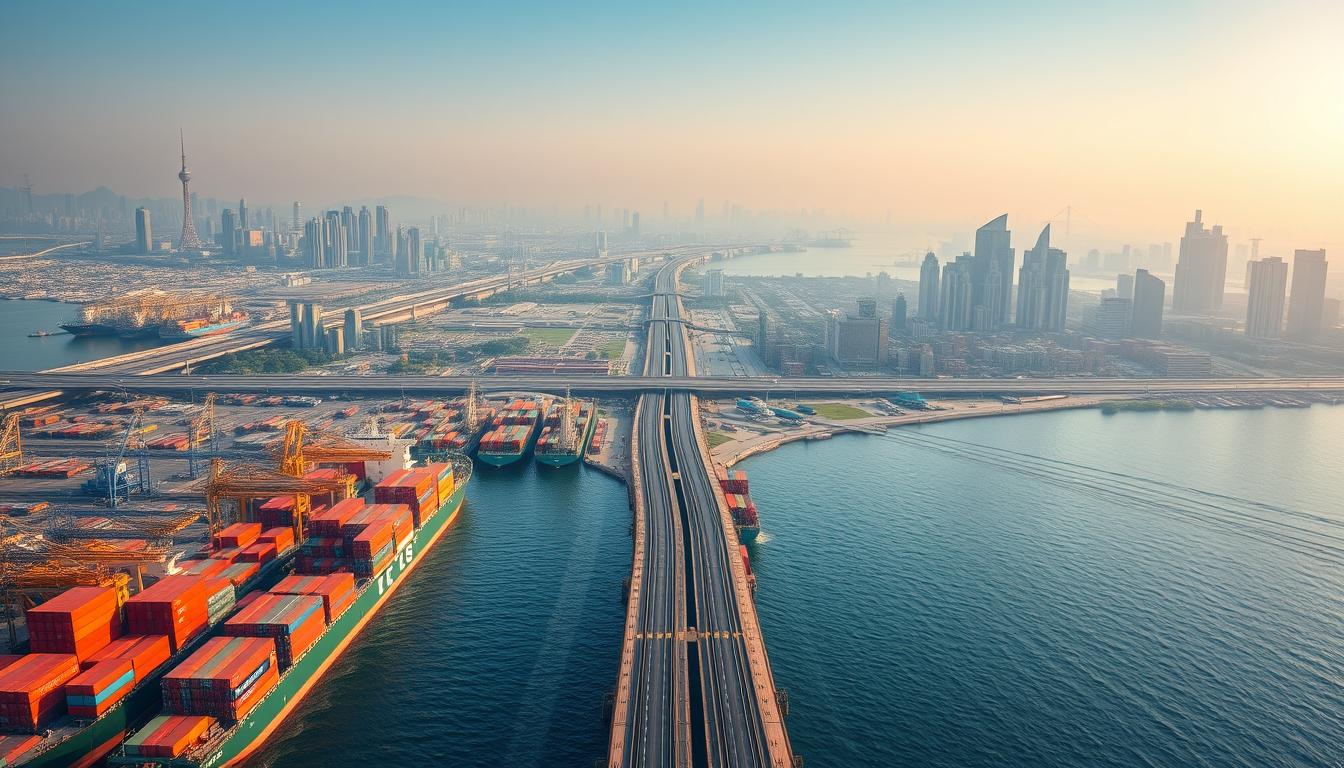Streamline your logistics in Asia with our curated list of the top 10 logistics companies serving the region.
Asia is a hub for international trade, with numerous leading logistics providers facilitating the movement of goods across the continent. The region’s rapid economic growth has driven the demand for efficient and reliable logistics services.

The top logistics companies in Asia have established themselves as key players in the industry, offering a range of services that cater to the diverse needs of businesses. These companies have invested heavily in technology and infrastructure to provide streamlined logistics solutions.
Key Takeaways
- Asia’s logistics market is driven by rapid economic growth.
- Top logistics companies offer a range of services, including transportation and warehousing.
- Technology plays a crucial role in modern logistics operations.
- The leading logistics providers have invested heavily in infrastructure.
- Efficient logistics services are essential for businesses operating in Asia.
The Growing Importance of Logistics in Asia
Asia’s economic landscape is significantly influenced by the growing importance of logistics. The region’s rapid economic growth, driven by globalization and e-commerce, has led to an increased demand for efficient logistics services.
The logistics industry in Asia is experiencing rapid expansion, with companies investing heavily in infrastructure, technology, and human resources. This growth is transforming the regional economy by enhancing supply chain efficiency and reducing costs.
A key factor driving the growth of logistics in Asia is the rise of e-commerce. Online shopping has surged in popularity, necessitating advanced logistics solutions to manage the increased volume of deliveries.
| Country | Logistics Market Size (2022) | Growth Rate (2023-2028) |
|---|---|---|
| China | $150 billion | 8% |
| India | $50 billion | 10% |
| Japan | $80 billion | 5% |
The importance of logistics in Asia’s economic landscape cannot be overstated. As the region continues to grow, the demand for logistics services will only increase, driving further investment and innovation in the sector.
Understanding the Logistics Market
The dynamics of the Asian logistics market are influenced by various factors, including economic growth and technological advancements.
The Asian logistics market is a complex and multifaceted industry, driven by the region’s economic growth, increasing trade volumes, and the rise of e-commerce. As noted by a logistics expert,
“The logistics sector is a critical component of the regional economy, facilitating the movement of goods and services across borders.”
The market dynamics are further complicated by factors such as infrastructure development, government regulations, and the adoption of new technologies like blockchain and artificial intelligence. For instance, the implementation of smart logistics solutions has improved supply chain efficiency and reduced costs.
Key drivers of the Asian logistics market include:
- Economic growth and increasing trade volumes
- Rise of e-commerce and changing consumer expectations
- Technological advancements, such as blockchain and AI
- Infrastructure development and government initiatives
Video source from youtube
The interplay of these factors has created a dynamic and rapidly evolving logistics landscape in Asia. As the market continues to grow, logistics companies must adapt to these changes to remain competitive.
The future of the Asian logistics market looks promising, with opportunities for growth and innovation. Companies that invest in technology, develop strategic partnerships, and focus on customer satisfaction are likely to thrive in this competitive environment.
Criteria for Selecting Top Logistics Companies
Several important criteria are used to determine the top logistics companies operating in Asia. When evaluating these companies, factors such as service range, technological capabilities, reliability, and customer service play a crucial role.
The service range of a logistics company is vital, as it determines the variety of services offered, from transportation to warehousing and customs clearance. Companies that provide a comprehensive suite of services are generally more capable of handling complex logistics needs.
| Criteria | Description | Importance Level |
|---|---|---|
| Service Range | Variety of services offered | High |
| Technological Capabilities | Use of advanced technology for tracking and management | High |
| Reliability | Consistency in delivering services on time | High |
| Customer Service | Quality of support provided to clients | Medium |
By considering these criteria, businesses can make informed decisions when selecting a logistics partner in Asia. The right logistics company can significantly enhance supply chain efficiency and overall business performance.
Top 10 Logistics Companies in Asia
With the rise of e-commerce and globalization, the top 10 logistics companies in Asia have emerged as crucial facilitators of international trade.
The Asian logistics market is highly competitive, with numerous companies vying for market share. Here, we list the top 10 logistics companies in Asia, known for their extensive networks, innovative services, and commitment to customer satisfaction.
DHL Supply Chain is a leading logistics company in Asia, offering a wide range of services including contract logistics, global forwarding, and supply chain management.
DB Schenker is another prominent player, providing land, air, and sea transport services along with comprehensive supply chain solutions.
The top 10 logistics companies in Asia are:
- DHL Supply Chain
- DB Schenker
- Kuehne + Nagel
- DSV
- Sinotrans
- Yusen Logistics
- NTG
- Hitachi Transport
- Agility
- Logwin
These companies have established themselves as leaders in the Asian logistics market through their innovative approaches and customer-centric services.

A comparative analysis of these companies reveals their strengths and areas of specialization. The following table provides an overview of their services and market presence.
| Company | Services | Market Presence |
|---|---|---|
| DHL Supply Chain | Contract Logistics, Global Forwarding | Strong presence in China, India, and Southeast Asia |
| DB Schenker | Land, Air, and Sea Transport, Supply Chain Solutions | Extensive network across Asia, including Japan and Korea |
| Kuehne + Nagel | Sea and Air Freight, Logistics Solutions | Significant presence in major Asian ports |
| DSV | Transport and Logistics Solutions | Strong coverage in Asia, with a focus on emerging markets |
| Sinotrans | Integrated Logistics Services | Leading presence in China and expanding across Asia |
The table highlights the diverse services offered by these logistics companies and their market presence across Asia.
These top logistics companies are driving innovation in the industry through the adoption of technology, such as AI, blockchain, and IoT, to enhance their services and operational efficiency.
Comparative Analysis of Leading Logistics Companies
A comparative analysis of top logistics companies reveals their unique strengths and operational strategies. The Asian logistics market is highly competitive, with several key players vying for dominance.
Leading logistics companies in Asia have been evaluated based on their service offerings, geographical coverage, and technological integration. Companies like DB Schenker, DHL, and Maersk have demonstrated exceptional capabilities in managing complex logistics operations.
The comparison highlights the diverse service portfolios of these companies. For instance, some specialize in cold chain logistics, while others excel in freight forwarding and supply chain management.
| Company | Service Offerings | Geographical Coverage |
|---|---|---|
| DB Schenker | Land Transport, Air & Ocean Freight, Contract Logistics | Asia, Europe, Americas |
| DHL | Express Parcel, Air & Ocean Freight, Contract Logistics | Global Coverage |
| Maersk | Container Shipping, Port Operations, Logistics Services | Global, with strong presence in Asia |
This comparative analysis underscores the importance of selecting a logistics partner that aligns with your business needs. By understanding the strengths and service offerings of top logistics companies, businesses can make informed decisions.
How to Partner with Top Logistics Companies
Selecting the right logistics partner is a strategic decision that can impact your business’s bottom line. To make an informed choice, it’s essential to understand the criteria that define top logistics companies.
Key Considerations for Partnering with Top Logistics Companies
- Assess their experience and expertise in handling logistics for businesses similar to yours.
- Evaluate their technology and infrastructure to ensure they can meet your needs.
- Review their customer service and support capabilities.
- Consider their ability to adapt to changing market conditions.
When evaluating potential logistics partners, it’s also crucial to consider their supply chain efficiency and how they can contribute to streamlining your business operations.
- Clearly communicate their needs and expectations.
- Establish clear performance metrics and monitoring processes.
- Foster a collaborative relationship to address any challenges that arise.
By following these guidelines and partnering with a top logistics company, businesses can enhance their supply chain efficiency, reduce costs, and improve customer satisfaction.
Emerging Logistics Companies to Watch
Asia is home to a new generation of logistics companies that are changing the industry. These emerging players are leveraging technology and innovative strategies to disrupt traditional logistics models.
Key Players: Some of the emerging logistics companies to watch include:
- Companies focusing on e-commerce logistics
- Startups offering specialized cold chain logistics
- Firms providing innovative last-mile delivery solutions
These companies are not only enhancing the efficiency of logistics operations but also improving customer experiences. The table below highlights some of these emerging companies and their areas of specialization.
| Company | Specialization | Region |
|---|---|---|
| LogisticsPro | E-commerce Logistics | Southeast Asia |
| ColdChain Masters | Cold Chain Logistics | India |
| LastMile Heroes | Last-Mile Delivery | China |
As the logistics landscape continues to evolve, these emerging companies are expected to play a significant role in shaping the future of the industry in Asia.
Future Trends in Logistics
Emerging trends in logistics are redefining the industry landscape in Asia, driven by technology and consumer demands. The logistics industry is becoming increasingly complex, with the need for faster, more efficient, and more sustainable operations.
The future of logistics in Asia is heavily influenced by digitalization. Technologies such as Artificial Intelligence (AI), Internet of Things (IoT), and blockchain are being adopted to enhance supply chain visibility and efficiency. For instance, AI-powered predictive analytics helps in forecasting demand and managing inventory.
Sustainability is another key trend shaping the logistics industry. Companies are focusing on reducing their carbon footprint by adopting eco-friendly practices and investing in electric or hybrid vehicles. This shift is driven by both regulatory pressures and consumer preferences for sustainable products.
| Trend | Description | Impact |
|---|---|---|
| Digitalization | Adoption of AI, IoT, and blockchain | Enhanced supply chain visibility and efficiency |
| Sustainability | Adoption of eco-friendly practices | Reduced carbon footprint |
| E-commerce Integration | Streamlining logistics for online sales | Faster and more reliable deliveries |

As the logistics landscape continues to evolve, companies that adapt to these trends will be better positioned to succeed in the competitive Asian market. The integration of e-commerce with logistics is also becoming crucial, enabling faster and more reliable deliveries.
Conclusion
The logistics industry in Asia is a rapidly evolving sector, driven by the region’s growing economic power and the increasing demand for fast and reliable supply chain solutions. As we’ve seen, top logistics companies are adapting to these changes by investing in technology, expanding their networks, and improving their services.
Companies like DHL, FedEx, and UPS are leading the way, leveraging their global networks and expertise to meet the complex needs of businesses in Asia. Meanwhile, emerging logistics companies are also making a mark by offering specialized services and innovative solutions.
As the region continues to grow, the logistics industry will play an increasingly important role in facilitating trade and commerce. By understanding the trends and developments in this industry, businesses can better navigate the complexities of logistics and capitalize on the opportunities available.
FAQ
What are the key factors driving the growth of the logistics industry in Asia?
The growth of the logistics industry in Asia is driven by factors such as increasing international trade, e-commerce boom, and rising demand for efficient supply chain management.
How do top logistics companies in Asia maintain their competitive edge?
Top logistics companies in Asia maintain their competitive edge through investments in technology, strategic partnerships, and a strong focus on customer service, as seen in companies like DHL and DB Schenker.
What services do leading logistics companies in Asia typically offer?
Leading logistics companies in Asia typically offer a range of services including freight forwarding, warehousing, transportation, and supply chain management, as provided by companies like Kuehne + Nagel and Nippon Express.
How can businesses partner with top logistics companies for their needs?
Businesses can partner with top logistics companies by assessing their logistics needs, researching potential partners, and evaluating the services and expertise offered by companies like Sinotrans and CMA CGM.
What are the emerging trends shaping the logistics industry in Asia?
Emerging trends shaping the logistics industry in Asia include the adoption of digital technologies, increased focus on sustainability, and the growth of e-commerce, as seen in the strategies of companies like JD Logistics and SF Express.
What criteria are used to select the top logistics companies in Asia?
The criteria used to select the top logistics companies in Asia include factors such as revenue, market share, service offerings, and customer satisfaction, as well as the company’s ability to adapt to changing market dynamics.
How is the logistics industry in Asia expected to evolve in the future?
The logistics industry in Asia is expected to evolve with the increasing use of automation, artificial intelligence, and blockchain technology, as well as a growing focus on sustainability and environmental responsibility.

